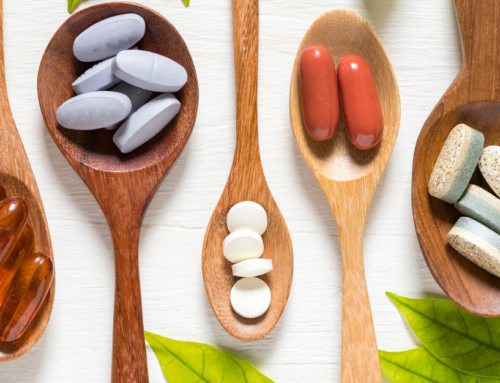Insulin resistance can be difficult to detect without medical tests. However, its effects can be dangerous if left unchecked.
This month we are taking a look at the risks and symptoms of insulin resistance, plus 10 preventative measures you can take to reduce your risks of insulin resistance and increase your insulin sensitivity.
 What Is Insulin Resistance?
What Is Insulin Resistance?
Insulin is a hormone produced by the pancreas which allows blood cells to absorb and use glucose. When a person experiences insulin resistance, their cells are unable to use insulin effectively. Consistently high levels of glucose develop, which can lead to prediabetes or type 2 diabetes if left untreated.
In order to prevent insulin resistance and its progression to diabetes, you must increase your insulin sensitivity. Insulin sensitivity means that your cells respond well to insulin—the opposite of resistance.
Who Is At Risk of Insulin Resistance?
Certain factors increase your likelihood of developing insulin resistance:
- Being overweight or obese, especially when excess weight is around the midsection
- A sedentary lifestyle or lack of exercise
- Smoking
- Consuming large amounts of alcohol
- Lack of sleep or sleep issues
- High levels of cholesterol
- High blood pressure
- A history of gestational diabetes
- A family history of diabetes
- A high-carbohydrate diet
- Sleep apnea
While it may not be possible to eliminate all risk factors as some are genetic, most are avoidable and doctors typically recommend lifestyle changes to prevent the condition.
What Are The Symptoms of Insulin Resistance?
Insulin resistance is difficult to detect without medical testing, as symptoms don’t usually present until the condition has developed into diabetes. The CDC has reported that over 85% of people with prediabetes do not know they have it. That’s unfortunate since lifestyle changes can reverse the development of diabetes.
High insulin and blood sugar levels are the hallmark symptoms of insulin resistance. Your health practitioner can use several methods to measure your blood sugar and insulin levels, such as an HOMA-IR test. Waist measurements in excess of 40 inches for men and 35 for women can also indicate insulin resistance.
In addition, there are links that have been drawn between insulin resistance and other health conditions:
- Acanthosis nigricans. This skin condition causes dark spots on the groin, armpits, and back of the neck. It can be an indicator of insulin resistance.
- Polycystic ovary syndrome (PCOS). There is often an overlap between PCOS and insulin resistance. The symptoms of PCOS include irregular menstruation, infertility, and painful periods.
- Major depressive disorder. High levels of insulin in the blood have also been associated with an increased likelihood of depression.
If you are experiencing any of these conditions or conditions, it may be worthwhile to seek a test for insulin levels and insulin resistance.
How To Prevent Insulin Resistance
There are numerous natural and science-backed ways you can increase your insulin sensitivity:
1 – Sleep more
Getting enough rest is important for your health in many ways. A lack of good sleep has been linked to reduced insulin sensitivity, so be sure to catch up on your Zs.
2 – Fit movement into your day
Regular physical activity is a major key to increasing insulin sensitivity. Exercise will move sugar into the muscles for storage and promote insulin sensitivity immediately. This can also help keep off excess weight, which is another risk factor for insulin resistance.
3 – Reduce stress
Recurrent stress keeps hormone levels high and increases blood sugar. Stress also makes the body more insulin resistant.
Practicing meditation, getting regular exercise, and other stress-reduction techniques like conscious breathing will help lower your stress and increase your insulin sensitivity.
4 – Choose your drinks carefully
Even seemingly “healthy” drinks like kombucha can be loaded with sugar. Limit alcohol including beer, spirits and wine, especially pre-made cocktails with added sugar.
Hydrate well with water, at least 2 L a day, and choose herbal or green tea which has been linked to improved sensitivity.
5 – Eat more fiber
Studies have found strong links between fiber intake and insulin sensitivity. Incorporate fiber-rich foods into your diet such as legumes, oatmeal, fruits, and vegetables.
6 – Add high-antioxidant foods to your diet
A diet that includes a variety of plants is highly beneficial for health. The antioxidants in brightly colored produce prevent inflammation in the body and boost insulin sensitivity. However, be sure not to eat too much fruit at once, as many types of fruit are high in sugar.
7 – Reduce carb intake
Carbohydrates are the primary stimulus of rising insulin levels. High-carb diets tend to lead to blood sugar spikes. Spread out your carb intake throughout the day to prevent this, eating smaller portions at regular intervals.
8 – Supplement wisely
In addition to a well-rounded diet, certain supplements can help increase insulin sensitivity. Magnesium, chromium, berberine, and resveratrol have all been studied for their effects on insulin, with positive results.
9 – Cut back on processed sugar
The two major processed sugars are high-fructose corn syrup and sucrose. These are different from the natural sugars found in nutrient-dense foods like fruits and vegetables. Many studies have found that high doses of fructose and sucrose increase insulin resistance. It is best to avoid candy, sugary beverages, cakes, and cookies.
10 – Cook with herbs and spices
The medicinal properties of herbs and spices have shown good potential for increasing insulin sensitivity. Cinnamon, ginger, and garlic are some popular and flavorful ingredients that have been shown to increase insulin sensitivity.
If you’d like to learn more about developing lifestyle habits for healthy insulin levels, don’t hesitate to reach out. Together, we can assess your symptoms and develop a plan. Contact our team today to setup a free phone consultation!
Sources
- Attvall S, Fowelin J, Lager I, Von Schenck H, Smith U. Smoking induces insulin resistance–a potential link with the insulin resistance syndrome. J Intern Med. 1993 Apr;233(4):327-32. doi: 10.1111/j.1365-2796.1993.tb00680.x. PMID: 8463765.
- Borghouts LB, Keizer HA. Exercise and insulin sensitivity: a review. Int J Sports Med. 2000 Jan;21(1):1-12. doi: 10.1055/s-2000-8847. PMID: 10683091.
- Donga E, van Dijk M, van Dijk JG, Biermasz NR, Lammers GJ, van Kralingen KW, Corssmit EP, Romijn JA. A single night of partial sleep deprivation induces insulin resistance in multiple metabolic pathways in healthy subjects. J Clin Endocrinol Metab. 2010 Jun;95(6):2963-8. doi: 10.1210/jc.2009-2430. Epub 2010 Apr 6. PMID: 20371664.
- Liu CY, Huang CJ, Huang LH, Chen IJ, Chiu JP, Hsu CH. Effects of green tea extract on insulin resistance and glucagon-like peptide 1 in patients with type 2 diabetes and lipid abnormalities: a randomized, double-blinded, and placebo-controlled trial. PLoS One. 2014 Mar 10;9(3):e91163. doi: 10.1371/journal.pone.0091163. PMID: 24614112; PMCID: PMC3948786.
- Medagama AB. The glycaemic outcomes of Cinnamon, a review of the experimental evidence and clinical trials. Nutr J. 2015 Oct 16;14:108. doi: 10.1186/s12937-015-0098-9. PMID: 26475130; PMCID: PMC4609100.
- Jalal R, Bagheri SM, Moghimi A, Rasuli MB. Hypoglycemic effect of aqueous shallot and garlic extracts in rats with fructose-induced insulin resistance. J Clin Biochem Nutr. 2007 Nov;41(3):218-23. doi: 10.3164/jcbn.2007031. PMID: 18299719; PMCID: PMC2243241.
- Li Y, Tran VH, Duke CC, Roufogalis BD. Gingerols of Zingiber officinale enhance glucose uptake by increasing cell surface GLUT4 in cultured L6 myotubes. Planta Med. 2012 Sep;78(14):1549-55. doi: 10.1055/s-0032-1315041. Epub 2012 Jul 24. PMID: 22828920.
- Guerrero-Romero F, Tamez-Perez HE, González-González G, Salinas-Martínez AM, Montes-Villarreal J, Treviño-Ortiz JH, Rodríguez-Morán M. Oral magnesium supplementation improves insulin sensitivity in non-diabetic subjects with insulin resistance. A double-blind placebo-controlled randomized trial. Diabetes Metab. 2004 Jun;30(3):253-8. doi: 10.1016/s1262-3636(07)70116-7. PMID: 15223977.
- Anderson RA, Cheng N, Bryden NA, Polansky MM, Cheng N, Chi J, Feng J. Elevated intakes of supplemental chromium improve glucose and insulin variables in individuals with type 2 diabetes. Diabetes. 1997 Nov;46(11):1786-91. doi: 10.2337/diab.46.11.1786. PMID: 9356027.
- Yin J, Xing H, Ye J. Efficacy of berberine in patients with type 2 diabetes mellitus. Metabolism. 2008 May;57(5):712-7. doi: 10.1016/j.metabol.2008.01.013. PMID: 18442638; PMCID: PMC2410097.
- Guerrero-Romero F, Tamez-Perez HE, González-González G, Salinas-Martínez AM, Montes-Villarreal J, Treviño-Ortiz JH, Rodríguez-Morán M. Oral magnesium supplementation improves insulin sensitivity in non-diabetic subjects with insulin resistance. A double-blind placebo-controlled randomized trial. Diabetes Metab. 2004 Jun;30(3):253-8. doi: 10.1016/s1262-3636(07)70116-7. PMID: 15223977.
- Anderson RA, Cheng N, Bryden NA, Polansky MM, Cheng N, Chi J, Feng J. Elevated intakes of supplemental chromium improve glucose and insulin variables in individuals with type 2 diabetes. Diabetes. 1997 Nov;46(11):1786-91. doi: 10.2337/diab.46.11.1786. PMID: 9356027.
- Paul-Labrador M, Polk D, Dwyer JH, Velasquez I, Nidich S, Rainforth M, Schneider R, Merz CN. Effects of a randomized controlled trial of transcendental meditation on components of the metabolic syndrome in subjects with coronary heart disease. Arch Intern Med. 2006 Jun 12;166(11):1218-24. doi: 10.1001/archinte.166.11.1218. PMID: 16772250.
- Caminhotto Rde O, Lima FB. Impaired glucose tolerance in low-carbohydrate diet: maybe only a physiological state. Am J Physiol Endocrinol Metab. 2013 Dec;305(12):E1521. doi: 10.1152/ajpendo.00580.2013. PMID: 24336921.





